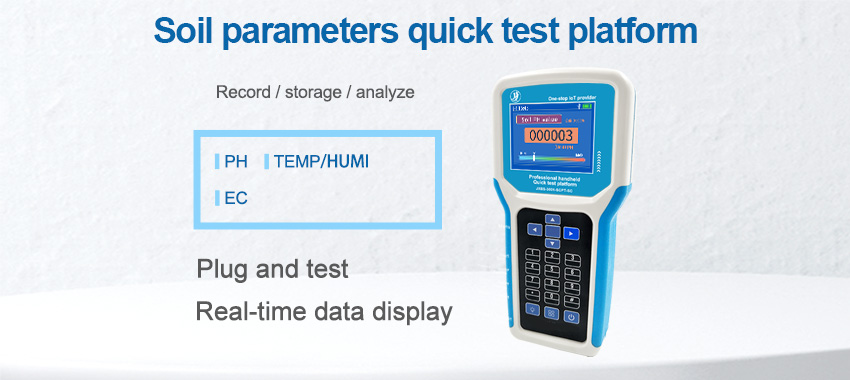Soil sensors play a crucial role in modern agriculture by providing valuable data on soil conditions and helping farmers make informed decisions for optimal crop management. These advanced devices measure various parameters such as moisture, temperature, pH, and fertility, enabling farmers to monitor soil health, conserve resources, and maximize yields. In this article, we will explore the applications and benefits of soil sensors in agriculture.

Soil Moisture Sensors:
Soil moisture sensors are essential tools for efficient irrigation management. They measure the water content in the soil, allowing farmers to determine when and how much water should be applied to their crops. By monitoring soil moisture levels, farmers can avoid under or over-irrigation, which can lead to water wastage or plant stress. Soil moisture sensors provide real-time data, helping farmers make timely irrigation decisions based on the actual needs of the plants. This optimization of water usage not only conserves water but also improves crop health and productivity.
Temperature Sensors:
Soil temperature plays a critical role in seed germination, nutrient availability, microbial activity, and overall plant growth. Temperature sensors help farmers monitor soil temperature variations throughout the growing season. By understanding the soil temperature patterns, farmers can determine the best time to plant their crops, apply fertilizers, and perform other critical operations. Temperature sensors also help identify potential issues such as soil cooling or overheating, which can affect crop development. With accurate soil temperature data, farmers can optimize planting schedules and implement suitable management practices.
pH Sensors:
Soil pH, which measures the acidity or alkalinity of the soil, has a significant impact on nutrient availability and plant growth. pH sensors enable farmers to monitor and manage soil pH levels effectively. By measuring soil pH, farmers can adjust their soil amendments and fertilizer applications accordingly. Maintaining the appropriate pH level ensures that essential nutrients are available to plants for optimal growth and development. pH sensors provide valuable insights into soil chemistry, allowing farmers to make informed decisions about lime applications, acidification treatments, or other necessary corrective measures.
Fertility Sensors:
Fertility sensors are valuable tools for assessing nutrient levels in the soil. They measure essential nutrients such as nitrogen (N), phosphorus (P), and potassium (K), as well as secondary and micronutrients. By monitoring soil fertility, farmers can precisely adjust their fertilization practices, ensuring that crops receive the right amount of nutrients. Fertility sensors provide real-time data, enabling farmers to detect nutrient deficiencies or excesses and apply fertilizers accordingly. This targeted approach not only optimizes crop nutrition but also reduces fertilizer waste and environmental impact.
Benefits of Soil Sensors:
a. Precision Agriculture: Soil sensors facilitate precision agriculture by providing accurate and localized data on soil conditions. This allows farmers to tailor their management practices, such as irrigation and fertilization, to specific areas within their fields. By applying resources precisely where needed, farmers can maximize crop growth, minimize input waste, and improve overall efficiency.
b. Resource Conservation:
Soil sensors help farmers conserve water, energy, and nutrients by optimizing resource usage. By monitoring soil moisture levels, farmers can avoid over-irrigation, reducing water consumption and conserving this valuable resource. Similarly, by measuring soil fertility and nutrient levels, farmers can apply fertilizers more efficiently, minimizing nutrient runoff and pollution.
c. Increased Yields and Quality:
By monitoring and managing soil conditions with the help of sensors, farmers can create an optimal environment for plant growth. Maintaining proper soil moisture, temperature, pH, and nutrient levels enhances crop development, leading to higher yields and improved crop quality. Soil sensors enable farmers to identify potential problems early on and take corrective actions, preventing yield losses.

d. Data-Driven Decision Making:
Soil sensors provide farmers with real-time data that can be integrated with other agricultural technologies, such as weather forecasts and crop models. By analyzing this data, farmers can make informed decisions about irrigation scheduling, fertilization rates, planting dates, and other crucial factors. Data-driven decision making improves the efficiency of farm operations and contributes to sustainable agricultural practices.
Conclusion:
Soil sensors have revolutionized agriculture by providing farmers with valuable information about soil moisture, temperature, pH, and fertility. These sensors enable precision agriculture, resource conservation, increased yields, and data-driven decision making. By utilizing soil sensors, farmers can optimize irrigation, fertilization, and other management practices, resulting in improved crop health, reduced environmental impact, and enhanced profitability. The continuous development and integration of soil sensors in agriculture contribute to sustainable farming practices and ensure efficient use of resources in the face of evolving global challenges.